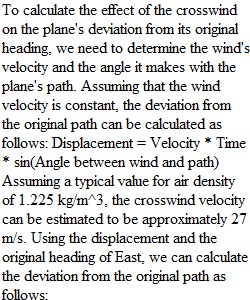


Q You are setting off on a trip to your destination located 600 km due East of your current location. You are flying a DA20 at a cruising speed of 170 km/h and pointing your plane directly East. The estimated total mass of the airplane is approximately 650 kg. Unknown to you, you experience a slight North-South crosswind which results in an additional force of 100 N on your plane half way through your trip for approximately 2 minutes. As a result your plane is now heading slightly South of East (and yes, for some unrealistic reason you don't correct your heading) . Only when your estimated flight time has elapsed do you notice that you have missed your destination! Approximately how far south of your destination have you ended up? A friend of yours follows you in the same aircraft but fully loaded at 730kg is he/she expected to end up with the same location? Rubric Modeling Modeling Criteria Ratings Pts This criterion is linked to a Learning OutcomeAccuracy All the ideas used in the diagram and/or narrative correspond to ideas established by the class thus far. (No ideas are used that have not been previously established and agreed on.) 5 pts This criterion is linked to a Learning OutcomeCompleteness All the established ideas and assumptions necessary to explain the event are included in the diagram and/or narrative. (No relevant ideas are missing.) 5 pts This criterion is linked to a Learning OutcomeClarity and Logical Reasoning The presentation is well done so that it flows logically and is easy to follow. It also explicitly connects the relevant ideas to the event being explained. 5 pts Total Points: 15 PreviousNext
View Related Questions